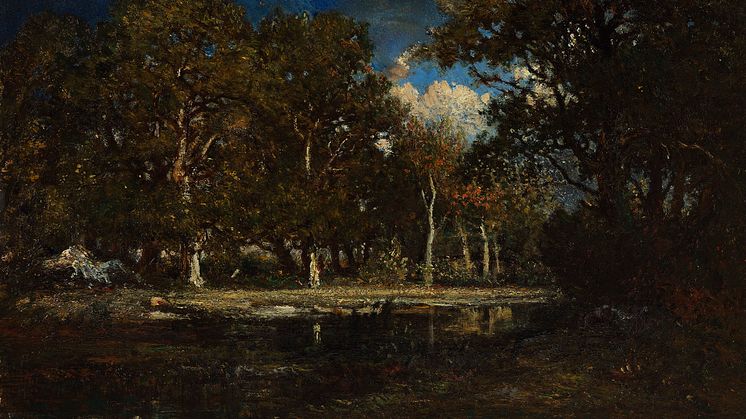
Press release -
Nationalmuseum acquires Rousseau landscape
Nationalmuseum has acquired a landscape painting of the Forest of Fontainebleau by Théodore Rousseau, believed to date from the 1840s. Rousseau was one of the most headstrong and innovative members of the French school of artists who took their name from the village of Barbizon and are considered the forerunners of the Impressionists. Over many years, Rousseau explored and documented various parts of the Fontainebleau forest.
Théodore Rousseau (1812–67) showed signs of artistic talent at an early age, but his rebellious nature soon brought him into conflict with his academically minded teacher, Jean-Charles-Joseph Rémond. As a result, he missed out on winning the prestigious Prix de Rome. Instead, at the age of just 18, Rousseau chose to go his own way with plein-air painting and a bohemian lifestyle. His landscapes soon caused a sensation among colleagues and collectors when they appeared at the Salon, and the buyers included royalty. The novel aspect was that Rousseau made use of the material characteristics of the paint itself, coupled with free brushwork, to create an atmospheric effect and a depth perspective in his landscapes. They were not necessarily painted from nature; rather, this was a technique that the artist was also able to refine in his studio.
Rousseau continued to enjoy success until 1836, when the Salon turned him down. That marked the start of a hermit-like existence and an even more radical approach to landscape art. He made his home on the edge of the Forest of Fontainebleau and soon became the central figure in a circle of artists. Rousseau not only drew on direct visual impressions and field studies, but also took inspiration from older artists, such as the 17th-century Dutch painter Jacob Ruysdael and the English landscape painter John Constable.
Rousseau spent several years endlessly roaming the Forest of Fontainebleau, and especially its desolate fringes, before settling permanently in the village of Barbizon in 1847. One of the locations he frequented was an area of marshland known as La Mare aux Evées. A decade earlier, work had started on digging ditches to drain this watery area, where large oak trees grew. The artist was fascinated by what he saw as a piece of unspoilt, authentic nature and rushed to document it before everything changed. In his depictions of the dense vegetation and its watery reflections, Rousseau used the outlines of the oaks to bring some order to the apparent chaos. One example is the painting recently acquired by Nationalmuseum, A Pond in the Forest. La Mare aux Evées, Forest of Fontainebleau, which is likely based on the artist’s many sketches.
“The overworked composition of the painting is characteristic of Rousseau,” according to Magnus Olausson, director of collections at Nationalmuseum. “The silhouette of an oak tree in the right foreground, almost asphalt black, is in stark contrast to the illuminated curtain of trees in the background and the dramatic sky with shades ranging from dark ultramarine to a light blue opening in the storm clouds. All this is elegantly reflected in the pond.”
The art establishment remained unmoved by Rousseau’s radical landscape paintings for many years. Although he was made a Knight of the Legion of Honour in 1852 and was awarded a gold medal at the world’s fair three years later, he was not fully rehabilitated until 1867, the year of his death. Early advocates of the artist’s comeback included Francis Petit, an art dealer, who was the first known owner of the painting just acquired by Nationalmuseum.
Nationalmuseum receives no state funds with which to acquire design, applied art and artwork; instead the collections are enriched through donations and gifts from private foundations and trusts. The acquisition has been made possible by a generous donation from the Sophia Giesecke Fund.
Inventory number
Théodore Rousseau: A Pond in the Forest.La Mare aux Evées, Forest of Fontainebleau, 1840s. Oil on panel. NM 7609.
Media enquiries
Magnus Olausson, director of collections, magnus.olausson@nationalmuseum.se, +46 8 5195 4371
Hanna Tottmar, head of press, press@nationalmuseum.se, +46 8 5195 4400
Categories
Nationalmuseum is Sweden’s museum of art and design. The collections comprise some 700 000 objects, including paintings, sculpture, drawings and graphic art from the 16th century up to the beginning of the 20th century and the collection of applied art and design up to the present day. Nationalmuseum’s responsibility is to preserve and make art accessible and provide knowledge.

